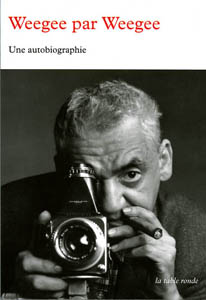Une autobiographie
WEEGEE
Editeur : La table ronde
Année de parution : 2009
Il est tout jeune lorsqu’il achète son premier appareil. Sa carrière commence alors qu’il squatte la chambre noir d’un studio de photo d’identité, où il est employé le jour: il s’en échappe la nuit pour couvrir les faits divers. Sans argent ni formation, il hante le QG de la police de Manhattan et devientainsi le photographe du crime
En 1945, il publie « Naked City » (La Cité sans voiles), qui lui ouvre les portes d’Hollywood. Les plus grands journaux, dont Life et Vogue, font appel à lui. Dans les années 1960, Weegee voyage à travers l’Europe et expérimente différent formats, dont les panoramiques et ses fameuses distorsions.
Mort le 6 décembre 1968 des suites d’une tumeur au cerveau, ce personnage ambigu, à la fois mégalomane et plein de compassion pour les déshérités, à inspiré à Howard Franklin le film « The Public Eye » (L’œil public), avec Joe Pesci.
"Tout ce que j’écris est vrai. Et j’ai les photos, les factures, les souvenirs et les cicatrices pour le prouver". Weegee by Weegee
An autobiography
Pioneer of photojournalism, precursor of tabloid photography and well-known artist, Arthur Felling, known as Weegee, was born in Austria in 1899. He emigrated to the United States of America when he was 10. Son of a rabbi, he grew up in the old buildings of the Lower East side in New York.
He was still very young when he bought his first camera. His career starts squatting in the dark room of the photo studio where he works during the day: he escapes the night to cover what happens.
He haunts the police general headquarters in Manhattan until he becomes a crime photographer.
In 1945, « Naked City » is published, opening to Arthur the door to Hollywood.
The most important magazines, for example Life and Vogue, contact him. During the ‘60s, Weegee travels all over Europe testing different sizes, as wide-angles and his famous distortions.
Died of brain cancer on December 26th 1968, this ambiguous character, at the same time megalomaniac and full of compassion for underprivileged people, inspired Howard Franklin for the movie «The Public Eye » (L‘œil public) with Joe Pesci.
“Everything I wrote is true. I have photos, bills, reminiscences and scars to prove it”.

Lettre d’information
75004 Paris – France
+33 (0)1 42 74 26 36
ouverture du mercredi au samedi
de 13h30 à 18h30. Entrée libre
M° Rambuteau – Les Halles
Pour Que l’Esprit Vive
20 rue Lalande
75014 Paris – France
T. 33(0)1 81 80 03 66
www.pqev.org

